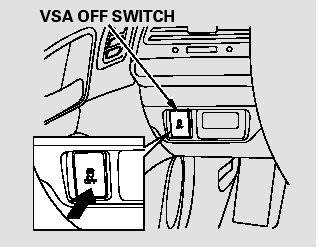Honda Accord: Vehicle Stability Assist (VSA ), aka Electronic Stability Control (ESC), System
 Honda Accord: Vehicle Stability Assist (VSA ), aka Electronic Stability
Control (ESC), System
Honda Accord: Vehicle Stability Assist (VSA ), aka Electronic Stability
Control (ESC), System
The vehicle stability assist (VSA) system helps to stabilize the vehicle during cornering if the vehicle turns more or less than desired. It also assists you in maintaining traction while accelerating on loose or slippery road surfaces. It does this by regulating the engine’s output and by selectively applying the brakes.
When VSA activates, you may notice that the engine does not respond to the accelerator in the same way it does at other times. There may also be some noise from the VSA hydraulic system. You will also see the VSA system indicator blink.
The VSA system cannot enhance the vehicle’s driving stability in all situations and does not control your vehicle’s entire braking system. It is still your responsibility to drive and corner at reasonable speeds and to leave a sufficient margin of safety.

VSA OFF Indicator
When VSA is off, the VSA OFF indicator comes on as a reminder.

Vehicle Stability Assist (VSA) System Indicator
When VSA activates, you will see the VSA system indicator blink.
If this indicator comes on while driving, pull to the side of the road when it is safe, and turn off the engine. Reset the system by restarting the engine. If the VSA system indicator stays on or comes back on while driving, have the VSA system inspected by your dealer.
NOTE: The main function of the VSA system is generally known as Electronic Stability Control (ESC).
The system also includes a traction control function.
If the low tire pressure indicator or TPMS indicator comes on, the VSA system automatically turns on even if the VSA system is turned off by pressing the VSA OFF switch. If this happens, you cannot turn the VSA system off by pressing the VSA OFF switch again.
Without VSA, your vehicle will have normal braking and cornering ability, but it will not have VSA traction and stability enhancement.
VSA OFF Switch

This switch is under the driver’s side vent. To turn the VSA system on and off, press and hold it until you hear a beep.
When VSA is off, the VSA OFF indicator comes on as a reminder.
Press and hold the switch again. It turns the system back on.
VSA is turned on every time you start the engine, even if you turned it off the last time you drove the vehicle.
In certain unusual conditions when your vehicle gets stuck in shallow mud or fresh snow, it may be easier to free it with the VSA temporarily switched off. When the VSA system is off, the traction control system is also off. You should only attempt to free your vehicle with the VSA off if you are not able to free it when the VSA is on.
Immediately after freeing your vehicle, be sure to switch the VSA on again. We do not recommend driving your vehicle with the VSA and traction control systems switched off.
VSA and Tire Sizes
Driving with varying tire or wheel sizes may cause the VSA to malfunction. When replacing tires, make sure they are of the same size and type as your original tires.
If you install winter tires, make sure they are the same size as those that were originally supplied with your vehicle. Exercise the same caution during winter driving as you would if your vehicle was not equipped with VSA.


